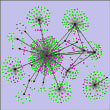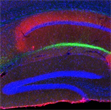Tuesday, 16 December 2014
The Infinitely Large, Infinitely Small, and Infinitely Complex

This week, we’re going to talk about nothing less than the place that the human brain occupies in the known universe. Let’s begin by recalling that, as stated often elsewhere on The Brain from Top to Bottom, the brain that each of us possesses is one of the most complex objects in that universe, which is already saying a lot.
The complexity of the human brain is one of the reasons that this website is organized the way it is. (more…)
From the Simple to the Complex | Comments Closed
Monday, 24 November 2014
Persistence of social signatures in human communication

No need to be impressed anymore by people who have 600 or 1400 “friends” on Facebook. Just like you and I, they are not really discussing their true feelings or anything else important with more than one or two dozen people at most. And for every individual, the size of this limited “hard core” of relationships seems to persist over time, even though the friends who compose it may change. These fascinating cognitive data come from a study entitled “Persistence of social signatures in human communication”, published in the journal Proceedings of the National Academy of Sciences of the United States of America in January 2014. (more…)
From Thought to Language | Comments Closed
Wednesday, 5 November 2014
A Brain Circuit That Links Two Events in Time

If you’re out in a storm and you see a bolt of lightning streak across the sky, you tend to pull your head down between your shoulders for the next few seconds, fearing the big thunderclap that you expect to come next. This kind of association between a stimulus and a potential danger is something that the human brain retains easily, because it has always had an obvious importance for our survival.
A study co-ordinated by MIT professor Susumu Tonegawa and published in the journal Science in January 2014 reveals the neuronal bases of this association between a stimulus and the timing of a potential danger, about which relatively little was previously known compared with the association with the other essential property of a danger: its location. In the latter case, the hippocampus, the key brain structure for encoding memories, makes use of place cells, which are activated when you are in or are remembering a specific location. (more…)
Memory and the Brain | Comments Closed
Monday, 20 October 2014
Reading Novels Increases Connectivity of Areas in the Brain

Immersing yourself in reading a good novel is an excellent way to take a break from the stresses of daily life. By seeing things from the protagonists’ point of view while you are reading those few hundred pages, not only do you feel as if you have access to another world, but you may also continue to have this feeling for some time, or even for your entire life, if the book has really made an impression on you.
The neurobiological bases of this phenomenon would appear to have been discovered in a study that Gregory S. Berns and his colleagues published in the journal Brain Connectivity in Fall 2013. The subjects in this study were 21 young adults. In the first phase of the study, the subjects received resting-state functional magnetic resonance imaging (fMRI) scans for five consecutive days. The researchers then used these scans to develop a general diagram of the connectivity of each subject’s brain. (more…)
Memory and the Brain | Comments Closed
Monday, 6 October 2014
Poverty Imposes a Cognitive Burden on the Brain

Neuroscience is providing growing evidence that poverty can have serious consequences not only for the health of people who are “struggling to make both ends meet” (something that has been known for a long time), but also on their cognitive abilities. The most recent of these studies looking specifically at this aspect of poverty was published in the journal Science in August 2013 by economist Anandi Mani and her colleagues.
Using two different approaches, this research team reached the same conclusion: for people at the low end of the socioeconomic spectrum, everyday life requires so much calculation and effort just to meet basic material needs (food, shelter, etc.) that it exhausts their mental capacities. (more…)
From Thought to Language | Comments Closed







